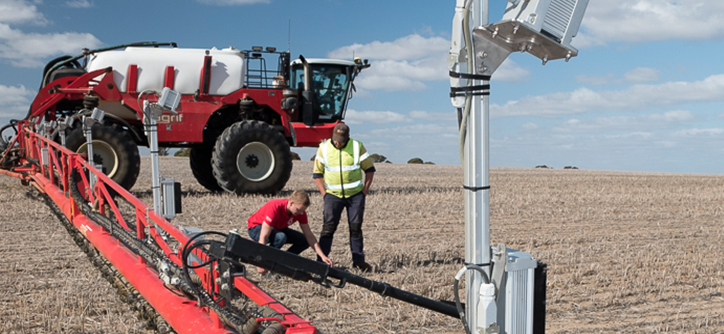The use of technology to make pesticide use more efficient through better control while using less pesticide is becoming increasingly important in modern agriculture. Unfortunately there is a growing mistrust within the general community of many agricultural practices.
Pesticide use is often misunderstood and the target of campaigns to eliminate the use of pesticides in food production. A highly relevant example of this is the war on genetically modified crops and consequently a war on the world’s most valuable and widely used herbicide glyphosate. As part of this trend European supermarkets are telling suppliers they want a 60% reduction in pesticide use.
Another issue growers must consider is the use of pesticide residues in grain and other products as a non-tariff trade barrier or a lever to force down the price for the commodity.
Therefore it is in the interests of the industry and farmers to not only be seen to be doing the right thing but to look at technologies that will enable a reduction of pesticide use while maintaining or increasing profitability.
In fallow weed management green-on-brown optical spot spray systems for detecting and spraying weeds is well-established with both the Weedseeker® and WEED-it™ ( https://www.weed-it.com/ ) now well established in Australian agriculture. These 2 technologies have the following similarities –
- measure the reflectance of green plants (using near infrared wavelengths) which triggers the weed to be sprayed
- have high numbers of sensors – Weedseeker™ has one per nozzle while WEED-it™ has one per metre
- can be used day and night as they have their own light source
- can reduce herbicide application by 80 to 90% (depending on density of weeds)
- by reducing area sprayed it also reduces number of tank fills required (fewer litres of spray mix per ha)
- restricted to speeds less than 20 km/h
- boom height control is critical to ensure adequate coverage of weeds
- coverage is affected by strong winds which moves the spray pattern away from the targeted weed
- relatively high cost for the unit of up to $4000 per metre
- being used for selective cultivation and targeting weeds with lasers and microwaves.
Optical spot spraying has also demonstrated not only reducing herbicide and water use but to improve management of herbicide resistant and hard-to-kill weeds by making it economic to use more expensive herbicides and at higher rates.
The next big step forward in spray technology is to be able to spot spray weeds within a crop or pasture, commonly known as a green-on-green spot spraying. Green-on-green spot spraying has been found to give the same level of reduced herbicide and water usage found in green-on-brown technology but does this in a crop or pasture.
How does in-crop (green-on-green) spot spraying of weeds happen?
The first research on spot spraying of weeds in a crop or pasture relied on comparing colour differences between the weed and the crop as well as leaf and plant shape. The systems worked well in the laboratory but failed in the paddock. The failure at field scale was due to a range of factors such as variable lighting such as bright sun versus overcast, shading, movement of plants from wind, and variable soil colour to name a few.
The big breakthrough in green-on-green weed detection was the development of artificial intelligence (AI) and deep learning (a subset of machine learning) which has greatly improved the capabilities of machine/computer vision. Cameras linked to AI is now the most widely used technology for machine/computer vision to differentiate between complex images such as weeds in a crop or facial recognition.
Three technological changes enabled the rapid advancement of artificial intelligence and deep learning:
- improved computing power through the use of graphics processing units (GPUs)
- huge sets of data (‘big data’)
- powerful and complex algorithms through the stacking of neural networks
Machine learning can be either supervised or unsupervised.
Guillaume Jourdain, CEO of Bilberry™, at the GRDC updates in early 2019 outlined how supervised deep learning is used for identifying wild radish in wheat.
Also separate all images into 2 sets, training set and testing set. Training set is only used for training, and testing set is only used for testing (images cannot be on both sets)
Once happy with the results of the algorithms, go into the paddock to test (paddock testing is the most crucial part of the process)
Gathering sufficient number of images in different situations (the data) such as bare soil, in wheat, or other crops and with different stubble loads is critical. Each image in the data set must have everything in the image identified which is very labour intensive and therefore expensive.
This then needs to be tested in the paddock.
When will green-on-green spot spraying be commercially available?
Several Australian universities are at the early commercialisation stage for their machine vision technologies, so the timelines are a unpredictable.
Blue River Technologies™ in the USA are operating their “See & Spray” weed control system on a limited basis in US cotton crops.
Bilberry™ have partnered with the Netherland’s Agrifac Machinery™ to use their system on Agrifac sprayers. Currently Agrifac™ and Bilberry™ have 80 machines operating 10 countries with 2 machines under development in Australia. Bilberry™ sees Australia as an exciting market for green-on-green spot spraying and is opening an office in Perth later in 2019. This partnership is planning to have well calibrated algorithms available for in-crop weed spot spraying in Australia by 2021.
It is also interesting to note that these machine vision systems will be used on autonomous robots for weed control and a myriad of other uses and a great deal of research is being conducted in Australia and around the world.




